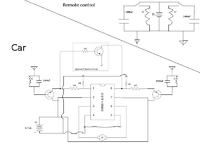Fworg64
Junior Member level 2

- Joined
- Mar 23, 2011
- Messages
- 21
- Helped
- 2
- Reputation
- 4
- Reaction score
- 2
- Trophy points
- 1,283
- Location
- North Dakota
- Activity points
- 1,441
Mainly concerned about the radio-ish stuff on it 'cause i followed the data sheet of the IC pretty close.

Also, what voltage should i run the remote control at?
And, any particular level of inductance for the inductors?
And, instead of the "optional protective circuit" do i still need to bridge those two points?
Thanks for any help!

Also, what voltage should i run the remote control at?
And, any particular level of inductance for the inductors?
And, instead of the "optional protective circuit" do i still need to bridge those two points?
Thanks for any help!

